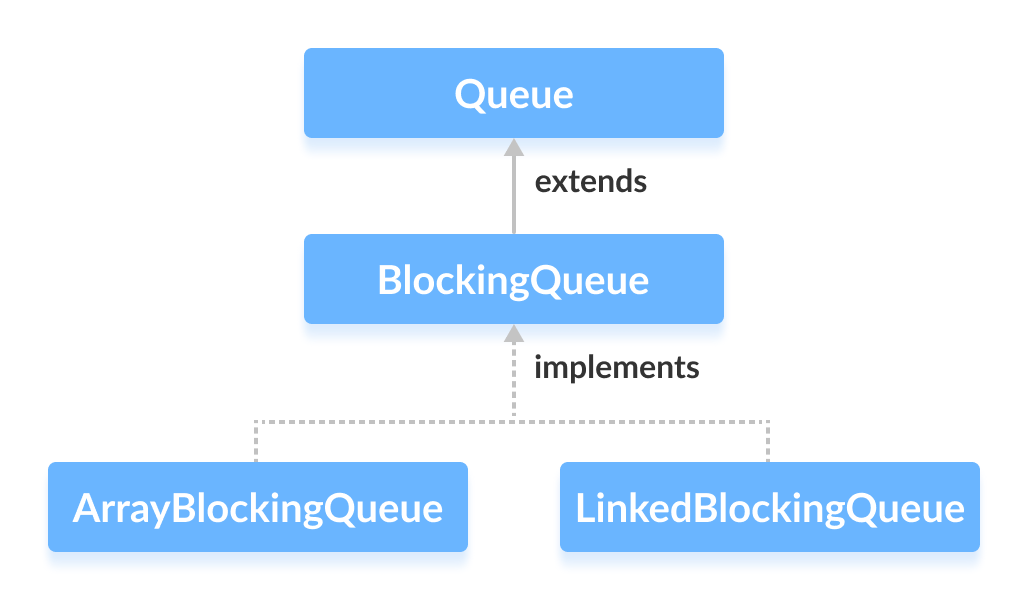Java Collections框架的BlockingQueue接口扩展了Queue接口。它允许任何操作等待成功执行。
例如,如果我们要从空队列中删除元素,则阻塞队列允许删除操作等待,直到队列中包含一些要删除的元素。
实现BlockingQueue的类
由于BlockingQueue是一个接口,因此我们无法提供它的直接实现。
为了使用BlockingQueue的功能,我们需要使用实现它的类。
- ArrayBlockingQueue
- LinkedBlockingQueue

如何使用阻塞队列?
为了使用BlockingQueue我们必须导入java.util.concurrent.BlockingQueue包。
// Array implementation of BlockingQueue
BlockingQueue animal1 = new ArraryBlockingQueue<>();
// LinkedList implementation of BlockingQueue
BlockingQueue animal2 = new LinkedBlockingQueue<>();
在这里,我们已经创建的对象animal1和类animal2 ArrayBlockingQueue和LinkedBlockingQueue分别。这些对象可以使用BlockingQueue接口的功能。
BlockingQueue的方法
根据队列是满还是空,阻塞队列的方法可以分为3类:
引发异常的方法
-
add()-在队列的末尾将元素插入到阻塞队列中。如果队列已满,则引发异常。 -
element()-返回阻塞队列的头部。如果队列为空,则引发异常。 -
remove()-从阻塞队列中删除一个元素。如果队列为空,则引发异常。
返回一些值的方法
-
offer()-将指定的元素插入到队列末尾的阻塞队列中。如果队列已满,则返回false。 -
peek()-返回阻塞队列的头部。如果队列为空,则返回null。 -
poll()-从阻塞队列中删除一个元素。如果队列为空,则返回null。
更多内容offer()和poll()
offer()和poll()方法可以与超时一起使用。也就是说,我们可以传递时间单位作为参数。例如,
offer(value, 100, milliseconds)
这里,
- value是要插入队列的元素
- 并且我们将超时设置为100毫秒
这意味着offer()方法将尝试将元素插入阻塞队列100毫秒。如果不能在100毫秒内插入元素,则该方法返回false 。
注意:除了milliseconds ,我们还可以在offer()和poll()方法中使用以下时间单位: days , hours , minutes , seconds , microseconds和nanoseconds 。
阻止操作的方法
BlockingQueue还提供了阻止操作并等待队列已满或为空的方法。
-
put()-将元素插入阻塞队列。如果队列已满,它将等待直到队列有空间插入元素。 -
take()-从阻塞队列中删除并返回一个元素。如果队列为空,它将等待直到队列中有要删除的元素。
假设我们想将元素插入队列。如果队列已满,则put()方法将等待,直到队列有空间插入元素。
同样,如果我们要从队列中删除元素。如果队列为空,则take()方法将等待直到队列包含要删除的元素。
ArrayBlockingQueue中BlockingQueue的实现
import java.util.concurrent.BlockingQueue;
import java.util.concurrent.ArrayBlockingQueue;
class Main {
public static void main(String[] args) {
// Create a blocking queue using the ArrayBlockingQueue
BlockingQueue numbers = new ArrayBlockingQueue<>(5);
try {
// Insert element to blocking queue
numbers.put(2);
numbers.put(1);
numbers.put(3);
System.out.println("BLockingQueue: " + numbers);
// Remove Elements from blocking queue
int removedNumber = numbers.take();
System.out.println("Removed Number: " + removedNumber);
}
catch(Exception e) {
e.getStackTrace();
}
}
}
输出
BlockingQueue: [2, 1, 3]
Removed Element: 2
要了解有关ArrayBlockingQueue更多信息,请访问Java ArrayBlockingQueue。
为什么选择BlockingQueue?
在Java中, BlockingQueue被视为线程安全的集合。这是因为它在多线程操作中可能会有所帮助。
假设一个线程正在将元素插入队列,而另一个线程正在从队列中删除元素。
现在,如果第一个线程运行速度较慢,则阻塞队列可使第二个线程等待,直到第一个线程完成其操作。